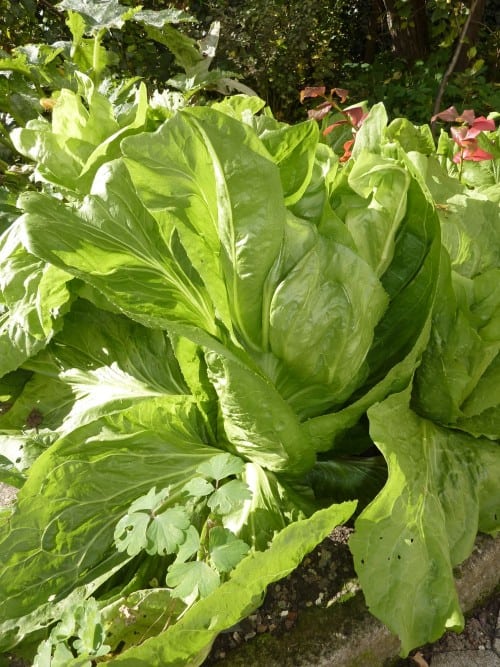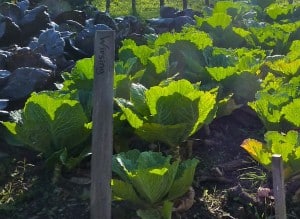
Vegetables vary in their need for sunlight, from partial shade, which is four to six hours of sunlight per day, to full sun, which is eight to twelve hours of sunlight per day.
Most vegetables, such as tomatoes, peppers, eggplant and squash, are true sun-worshippers, happiest when they bake in the sun from early morning to sundown. These plants work hard to produce large leaves, succulent fruit and sprawling vines, and need ample sunlight, water and nutrients to grow.
Leafy vegetables require less sun because they don’t develop fruit or vines. These plants actually prefer cool temperatures and become bitter or develop seed heads when temperatures soar. Leafy vegetables grow well in partial shade, especially in hot climates.
Root vegetables, such as potatoes, carrots, parsnips and beets lie somewhere in between. They need more sun than leafy vegetables, usually about six or more hours of sun daily.
Don’t despair if your garden lies under trees that provide dappled light. Leafy greens and root crops will grow successfully, although their growth might not be as luxurious as those plants grown in full sun. Full shade is another story; all vegetables will likely struggle under these conditions. Try the following shade-loving vegetables in your partial-shade garden or container garden.
1. Cooking greens. Cooking greens, such as kale, collards, mustard greens and Swiss chard, were a mainstay for Colonial cooks, but are underutilized today, which is a shame because these plants are easy to grow and chock-full of vitamins. Kale varieties to try include ‘Dwarf Blue Curled Scotch’ and ‘Siberian Improved.’ Try ‘Ruby Chard,’ which is dark green with crimson stems and veins.
2. Lettuce. Try the soft, loose-leaf types of lettuce, as opposed to head lettuce, which tends to go to seed more quickly. Keep the soil moist so the leaves are tender and mild, and plant several varieties. A mixture of colors and textures not only tastes great, but looks gorgeous arranged in the garden like a patchwork quilt. Cut lettuce at the base of the plant and allow it to grow back for a continuous harvest, or grow it in a container. Try “Oakleaf,’ ‘Ruby Red,’ or ‘Salad Bowl.’
3. Other Salad Greens. Once you’ve succeeded at lettuce, explore the more exotic salad greens, such as sorrel, endive and arugula. These greens cost a fortune in the grocery store, but grow just as easily as lettuce. Try ‘Florida Deep Heart’ curly endive or ‘Mammoth Lyon’ French sorrel.
4. Herbs. Several herbs tolerate, and even prefer partial shade. Try mint, chervil, coriander or parsley. Mint grows enthusiastically even when neglected, so plant it by itself or in a container.
5. Broccoli. Versatile broccoli grows in full-sun, but tolerates partial-shade, and may be less likely to bolt in the shade when temperatures climb. Try ‘Waltham 29’ or ‘Green Comet Hybrid.’ Cut broccoli back, like lettuce, for multiple harvests.

6. Cabbage. Related to broccoli, cabbage also benefits from cool temperatures and partial-shade. Try ‘Stonehead,’ or ‘Danish Ballhead’ for green cabbage, or ‘Red Acre’ for red.
7. Carrots. Carrots thrive in cool temperatures and moist soils. Plant half-long types, such as ‘Danvers Half-Long’ if you have heavy soils or utilize container gardens.
8. Beets. Like carrots, beets need cool, moist soils. In warm temperatures, they tend to turn woody and hard. Start them in early spring and harvest them eight weeks later, depending on the variety. Try the old standby, “Detroit Dark Red’ or ‘Little Ball,’ a miniature version suitable for containers.
9. Potatoes. Potatoes have a reputation for being difficult to grow, and it’s true that they are prone to disease and have specific soil requirements. But if you’d like to try your hand at growing them, start with disease-free seed potatoes and choose a variety known to thrive in your area. Old favorites include ‘Red Pontiac,’ ‘Irish Cobbler’ and ‘Fingerling.’
10. Turnips. Unpretentious and hard-working turnips deserve a place in the partial-shade garden. Try “American Purple Top,’ Long Island Improved’ or ‘Macomber.’
If your garden lacks sun, you may not be able to grow beefsteak tomatoes, but there’s no reason why you can’t savor home-grown produce. Choose plants that tolerate shade and plant them in early spring, as soon as the soil is soft.
If you enjoyed this article, want to know more about this or other related interesting topics, please like and share this article. Be sure to like us, so you don’t miss anything, we are Sweet Basil Farm & Gardens, on Facebook and other social media. We are a local producer of farm fresh fruits and vegetables and members of the American Poultry Association, licensed by the Georgia Dept. of Agriculture as Poultry Dealers and Brokers, and a proud member of the Georgia Grown program, a division of the Georgia Dept. of Agriculture. We also breed, sell and ship poultry, pet pigs, bearded irises and much more. We have an 80 acre working farm, putting great emphasis on all natural gardening and livestock management practices. An 1840s general store is situated on our property, and serves as our on-site farmer’s market. Conveniently located off of Interstate 75 near the Johnstonville Rd exit (#193). We are six miles west, located in Barnesville, Lamar County, Georgia.
Special thanks to gardening channel.com of republishing this interesting and informative article, as well as contributions from J. David Matthews, of Barnesville, Georgia in preparation of this article.
No comments:
Post a Comment